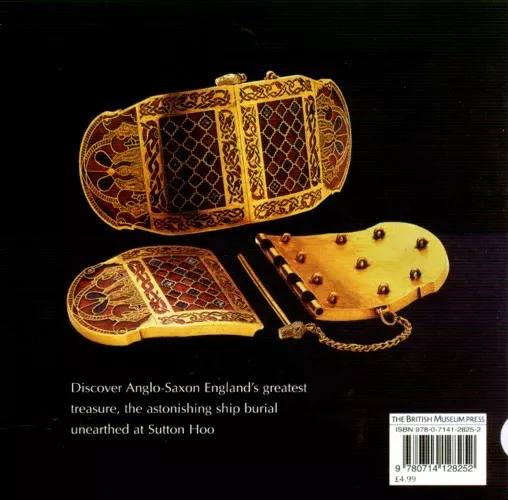Sutton Hoo Treasures Anglo-Saxon Ship Burial Scandinavian Jewelry Sword Helmet
"Treasures from Sutton Hoo" by Gareth Williams.
NOTE: We have 100,000 books in our library, over 10,400 different titles. Odds are we have other copies of this same title in varying conditions, some less expensive, some better condition. We might also have different editions as well (some paperback, some hardcover, oftentimes international editions). If you don’t see what you want, please contact us and ask. We’re happy to send you a summary of the differing conditions and prices we may have for the same title.
DESCRIPTION: Paperback. Publisher: British Museum (2011). Pages: 48. Size: 7½ x 7¼ inches. The objects unearthed in 1939 from an Anglo-Saxon ship-burial at Sutton Hoo, Suffolk, rank among the most splendid treasures in the collection of the British Museum. Bringing together fine craftsmanship from England, Germany, Scandinavia, Alexandria and far Byzantium, the spectacular finds included gold and garnet jewelry, silverware, drinking vessels with silver-gilt fittings, a lyre and a scepter, as well as the iconic helmet, all deliberately buried in the early seventh century as grave-goods for an important, though unidentified, warrior. The Sutton Hoo ship-burial was one of the most exciting discoveries ever made in British archaeology. This beautifully designed introduction to the treasure details the most significant pieces contained within it and explores the circumstances of its burial, discovery and excavation, as well as its lasting legacy and fame.
CONDITION: NEW. New oversized softcover. British Museum Press (2011) 48 pages. Unblemished, unmarked, pristine in every respect. Pages are pristine; clean, crisp, unmarked, unmutilated, tightly bound, unambiguously unread. Satisfaction unconditionally guaranteed. In stock, ready to ship. No disappointments, no excuses. PROMPT SHIPPING! HEAVILY PADDED, DAMAGE-FREE PACKAGING! Meticulous and accurate descriptions! Selling rare and out-of-print ancient history books on-line since 1997. We accept returns for any reason within 30 days! #8352a.
PLEASE SEE DESCRIPTIONS AND IMAGES BELOW FOR DETAILED REVIEWS AND FOR PAGES OF PICTURES FROM INSIDE OF BOOK.
PLEASE SEE PUBLISHER, PROFESSIONAL, AND READER REVIEWS BELOW.
PUBLISHER REVIEWS:
REVIEW: Gareth A beautifully designed introduction to the most spectacular hoard of Anglo-Saxon treasure ever found. The objects unearthed in 1939 from an Anglo-Saxon ship-burial at Sutton Hoo, Suffolk, rank among the most splendid treasures in the collection of the British Museum. Bringing together fine craftsmanship from England, Germany, Scandinavia, Alexandria and far Byzantium, the spectacular finds included gold and garnet jewellery, silverware, drinking vessels with silver-gilt fittings, a lyre and a sceptre, as well as the iconic helmet, all deliberately buried in the early seventh century as grave-goods for an important, though unidentified, warrior. The Sutton Hoo ship-burial was one of the most exciting discoveries ever made in British archaeology. This beautifully designed introduction to the treasure details the most significant pieces contained within it and explores the circumstances of its burial, discovery and excavation, as well as its lasting legacy and fame.
The author Gareth Williams is a curator in the Department of Coins and Medals in the British Museum with responsibility for early medieval coinage, and co-author of The Vale of York Hoard (British Museum Objects in Focus series, 2010).
PROFESSIONAL REVIEWS:
REVIEW: A slim souvenir style book, packed full of beautiful pictures of the famous artifacts discovered at Sutton Hoo. The text looks at the history of archaeology at the site, the context of the burial and at what the various finds can tell us about early Anglo-Saxon kingship. Exceptionally well done.
REVIEW: The objects unearthed in 1939 from an Anglo-Saxon ship-burial at Sutton Hoo, Suffolk, rank among the most splendid treasures in the collection of the British Museum. The Sutton Hoo ship-burial was one of the most exciting discoveries ever made in British archaeology. This title explores the circumstances of its burial, discovery and excavation. Excellent
READER REVIEWS:
REVIEW: This little book has excellent pictures of many of the gold-work and garnet inlay objects found in the Sutton Hoo ship burial site along with images of recreations of several of the artifacts including the iconic Anglo-Saxon helmet, sword and sword belt with its gold fittings and dragon-like gold buckle (shown on the cover). There is a nice timeline and the text is well-written and informative. This book is an excellent introduction which leaves a reader wanting to learn more.
REVIEW: The photography catches one's eye; the explanations and history inform and delight. This book is a perfect introduction for readers who do not necessarily want a long tome, and a piquant taste for those who long to hunger for an archeological, artistic, and historical feast that can be found elsewhere.
REVIEW: We picked up this book at the last IMC (International Medieval Congress), it was irresistible with lovely photographs of a stunning group of work. If you're looking for an in-depth examination of the artifacts or burial report, this isn't it. What it is, however, is a lovely and easy-to read and enjoy survey of some of the most beautiful pieces of work of the Anglo-Saxon age.
REVIEW: This is a very good simple straight forward presentation of the history of the site and its treasures. It is ideal as an introduction to someone with little knowledge of the importance of the site. It has interesting pictures and a well presented text.
REVIEW: Shedding light on a complex people the Anglo-Saxons this book is well organised written and illustrated. The pictures show the complexity of their craftsmanship and give a indication of the cultural importance of Sutton Hoo.
REVIEW: I bought this as a gift, and it is a super little book with excellent color photos and good information.
REVIEW: My husband was looking for a book about treasures of Sutton Hoo. He was very pleased with this book,
REVIEW: Astonishing details about early Saxon Gold.
REVIEW: I wanted a reference of exactly was found in this dig and not others mixed in. This was it. There is enough information in it for me too. It isn't a deep archeological tract, but what I needed to know about possible dating.
REVIEW: Very interesting book, has many facts about The British Museum, useful in reference.
ADDITIONAL BACKGROUND:
ANGLO-SAXON ENGLAND: The Anglo-Saxons were a people who inhabited Great Britain from the 5th century. They comprise people from Germanic tribes who migrated to the island from continental Europe, their descendants, and indigenous British groups who adopted some aspects of Anglo-Saxon culture and language. Historically, the Anglo-Saxon period denotes the period in Britain between about 450 and 1066, after their initial settlement and up until the Norman conquest.
The early Anglo-Saxon period includes the creation of an English nation, with many of the aspects that survive today, including regional government of shires and hundreds. During this period, Christianity was established and there was a flowering of literature and language. Charters and law were also established. The term Anglo-Saxon is popularly used for the language that was spoken and written by the Anglo-Saxons in England and eastern Scotland between at least the mid-5th century and the mid-12th century. In scholarly use, it is more commonly called Old English.
The history of the Anglo-Saxons is the history of a cultural identity. It developed from divergent groups in association with the people's adoption of Christianity, and was integral to the establishment of various kingdoms. Threatened by extended Danish invasions and military occupation of eastern England, this identity was re-established; it dominated until after the Norman Conquest. The visible Anglo-Saxon culture can be seen in the material culture of buildings, dress styles, illuminated texts and grave goods.
Behind the symbolic nature of these cultural emblems, there are strong elements of tribal and lordship ties. The elite declared themselves as kings who developed burhs, and identified their roles and peoples in Biblical terms. Above all, as Helena Hamerow has observed, "local and extended kin groups remained...the essential unit of production throughout the Anglo-Saxon period." The effects persist in the 21st century as, according to a study published in March 2015, the genetic make up of British populations today shows divisions of the tribal political units of the early Anglo-Saxon period.
The early Anglo-Saxon period covers the history of medieval Britain that starts from the end of Roman rule. It is a period widely known in European history as the Migration Period, also the Völkerwanderung ("migration of peoples" in German). This was a period of intensified human migration in Europe from about 400 to 800. The migrants were Germanic tribes such as the Goths, Vandals, Angles, Saxons, Lombards, Suebi, Frisii and Franks; they were later pushed westwards by the Huns, Avars, Slavs, Bulgars and Alans. By the year 400, southern Britain – that is Britain below Hadrian's Wall – was a peripheral part of the western Roman Empire, occasionally lost to rebellion or invasion, but until then always eventually recovered. Around 410, Britain slipped beyond direct imperial control into a phase which has generally been termed "sub-Roman".
The migrations according to Bede, who wrote some 300 years after the event; there is archeological evidence that the settlers in England came from many of these continental locations. The traditional narrative of this period is one of decline and fall, invasion and migration; however, the archaeologist Heinrich Härke stated in 2011: "It is now widely accepted that the Anglo-Saxons were not just transplanted Germanic invaders and settlers from the Continent, but the outcome of insular interactions and changes.
Writing in about 540 Gildas mentions that, sometime in the 5th century, a council of leaders in Britain agreed that some land in the east of southern Britain would be given to the Saxons on the basis of a treaty, a foedus, by which the Saxons would defend the Britons against attacks from the Picts and Scoti in exchange for food supplies. The most contemporaneous textual evidence is the Chronica Gallica of 452 which records for the year 441: "The British provinces, which to this time had suffered various defeats and misfortunes, are reduced to Saxon rule."
This is an earlier date than that of 451 for the "coming of the Saxons" used by Bede in his Historia ecclesiastica gentis Anglorum, written around 731. It has been argued that Bede misinterpreted his (scanty) sources, and that the chronological references in the Historia Britonnum yield a plausible date of around 428. Gildas recounts how a war broke out between the Saxons and the local population – Higham calls it the "War of the Saxon Federates" – which ended shortly after the siege at 'Mons Badonicus'. The Saxons go back to "their eastern home".
Gildas calls the peace a "grievous divorce with the barbarians". The price of peace, Nick Higham argues, is a better treaty for the Saxons, giving them the ability to receive tribute from people across the lowlands of Britain. The archaeological evidence agrees with this earlier timescale. In particular, the work of Catherine Hills and Sam Lucy on the evidence of Spong Hill has moved the chronology for the settlement earlier than 450, with a significant number of items now in phases before Bede's date.
This vision of the Anglo-Saxons exercising extensive political and military power at an early date remains contested. The most developed vision of a continuation in sub-Roman Britain, with control over its own political and military destiny for well over a century, is that of Kenneth Dark, who suggests that the sub-Roman elite survived in culture, politics and military power up to about 570.
However, Nick Higham seems to agree with Bede, who identified three phases of settlement: an exploration phase, when mercenaries came to protect the resident population; a migration phase, which was substantial as implied by the statement that Anglus was deserted; and an establishment phase, in which Anglo-Saxons started to control areas, implied in Bede's statement about the origins of the tribes. Scholars have not reached consensus on the number of migrants who entered Britain in this period. Heinrich Härke suggests that the figure is around 100,000, based on the molecular evidence. But, archaeologists such as Christine Hills and Richard Hodges suggest the number is nearer 20,000. By around 500 the Anglo-Saxon migrants were established in southern and eastern Britain.
What happened to the indigenous Brittonic people is also subject to question. Heinrich Härke and Richard Coates point out that they are invisible archaeologically and linguistically. But based on a fairly high Anglo-Saxon figure (200,000) and a low Brythonic one (800,000), Brythonic people are likely to have outnumbered Anglo-Saxons by at least four to one. The interpretation of such figures is that while "culturally, the later Anglo-Saxons and English did emerge as remarkably un-British...their genetic, biological make-up is none the less likely to have been substantially, indeed predominantly, British".
The development of Anglo-Saxon culture is described by two processes. One is similar to culture changes observed in Russia, North Africa and parts of the Islamic world, where a powerful minority culture becomes, over a rather short period, adopted by a settled majority. The second process is explained through incentives. Nick Higham summarized in this way: "As Bede later implied, language was a key indicator of ethnicity in early England. In circumstances where freedom at law, acceptance with the kindred, access to patronage, and the use and possession of weapons were all exclusive to those who could claim Germanic descent, then speaking Old English without Latin or Brittonic inflection had considerable value.
By the middle of the 6th century, some Brythonic people in the lowlands of Britain had moved across the sea to form Brittany, and some had moved west, but the majority were abandoning their past language and culture and adopting the new culture of the Anglo-Saxons. As they adopted this language and culture, the barriers began to dissolve between peoples, who had earlier lived parallel lives. The archaeological evidence shows considerable continuity in the system of landscape and local governance, which was inherited from the indigenous community. There is evidence for a fusion of culture in this early period.
Brythonic names appear in the lists of Anglo-Saxon elite. The Wessex royal line was traditionally founded by a man named Cerdic, an undoubtedly Celtic name ultimately derived from Caratacus. This may indicate that Cerdic was a native Briton, and that his dynasty became anglicized over time. A number of Cerdic's alleged descendants also possessed Celtic names, including the 'Bretwalda' Ceawlin. The last man in this dynasty to have a Brythonic name was King Caedwalla, who died as late as 689.
In the last half of the 6th century, four structures contributed to the development of society; they were the position and freedoms of the ceorl, the smaller tribal areas coalescing into larger kingdoms, the elite developing from warriors to kings, and Irish monasticism developing under Finnian (who had consulted Gildas) and his pupil Columba. The Anglo-Saxon farms of this period are often falsely supposed to be "peasant farms". However, a ceorl, who was the lowest ranking freeman in early Anglo-Saxon society, was not a peasant but an arms-owning male with the support of a kindred, access to law and the wergild; situated at the apex of an extended household working at least one hide of land.
The farmer had freedom and rights over lands, with provision of a rent or duty to an overlord who provided only slight lordly input. Most of this land was common outfield arable land (of an outfield-infield system) that provided individuals with the means to build a basis of kinship and group cultural ties. The Tribal Hidage lists thirty-five peoples, or tribes, with assessments in hides, which may have originally been defined as the area of land sufficient to maintain one family. The assessments in the Hidage reflect the relative size of the provinces.
Although varying in size, all thirty-five peoples of the Tribal Hidage were of the same status, in that they were areas which were ruled by their own elite family (or royal houses), and so were assessed independently for payment of tribute. By the end of the sixth century, larger kingdoms had become established on the south or east coasts. They include the provinces of the Jutes of Hampshire and Wight, the South Saxons, Kent, the East Saxons, East Angles, Lindsey and (north of the Humber) Deira and Bernicia. Several of these kingdoms may have had as their initial focus a territory based on a former Roman civitas.
By the end of the sixth century, the leaders of these communities were styling themselves kings, though it should not be assumed that all of them were Germanic in origin. The Bretwalda concept is taken as evidence of a number of early Anglo-Saxon elite families. What Bede seems to imply in his Bretwalda is the ability of leaders to extract tribute, overawe and/or protect the small regions, which may well have been relatively short-lived in any one instance. Ostensibly "Anglo-Saxon" dynasties variously replaced one another in this role in a discontinuous but influential and potent roll call of warrior elites.
Importantly, whatever their origin or whenever they flourished, these dynasties established their claim to lordship through their links to extended kin ties. As Helen Peake jokingly points out, "they all just happened to be related back to Woden". The process from warrior to cyning – Old English for king – is described in Beowulf (as translated by Seamus Heaney): "There was Shield Sheafson, scourge of many tribes, a wrecker of mead-benches, rampaging among foes. This terror of the hall-troops had come far. A foundling to start with, he would flourish later on. As his powers waxed and his worth was proved. In the end each clan on the outlying coasts. Beyond the whale-road had to yield to him. And begin to pay tribute. That was one good king.
In 565, Columba, a monk from Ireland who studied at the monastic school of Moville under St. Finnian, reached Iona as a self-imposed exile. The influence of the monastery of Iona would grow into what Peter Brown has described as an "unusually extensive spiritual empire," which "stretched from western Scotland deep to the southwest into the heart of Ireland and, to the southeast, it reached down throughout northern Britain, through the influence of its sister monastery Lindisfarne." In June 597 Columba died. At this time, Augustine landed on the Isle of Thanet and proceeded to King Aethelberht's main town of Canterbury.
He had been the prior of a monastery in Rome when Pope Gregory the Great chose him in 595 to lead the Gregorian mission to Britain to Christianize the Kingdom of Kent from their native Anglo-Saxon paganism. Kent was probably chosen because Aethelberht had married a Christian princess, Bertha, daughter of Charibert I the King of Paris, who was expected to exert some influence over her husband. Aethelberht was converted to Christianity, churches were established, and wider-scale conversion to Christianity began in the kingdom. Aethelberht's law for Kent, the earliest written code in any Germanic language, instituted a complex system of fines.
Kent was rich, with strong trade ties to the continent, and Aethelberht may have instituted royal control over trade. For the first time following the Anglo-Saxon invasion, coins began circulating in Kent during his reign. In 635 Aidan, an Irish monk from Iona chose the Isle of Lindisfarne to establish a monastery and close to King Oswald's main fortress of Bamburgh. He had been at the monastery in Iona when Oswald asked to be sent a mission to Christianize the Kingdom of Northumbria from their native Anglo-Saxon paganism.
Oswald had probably chosen Iona because after his father had been killed he had fled into south-west Scotland and had encountered Christianity, and had returned determined to make Northumbria Christian. Aidan achieved great success in spreading the Christian faith, and since Aidan could not speak English and Oswald had learned Irish during his exile, Oswald acted as Aidan's interpreter when the latter was preaching. Later, Northumberland's patron saint, Saint Cuthbert, was an abbot of the monastery, and then Bishop of Lindisfarne.
An anonymous life of Cuthbert written at Lindisfarne is the oldest extant piece of English historical writing, and in his memory a gospel (known as the St Cuthbert Gospel) was placed in his coffin. The decorated leather bookbinding is the oldest intact European binding. In 664, the Synod of Whitby was convened and established Roman practice (in style of tonsure and dates of Easter) as the norm in Northumbria, and thus "brought the Northumbrian church into the mainstream of Roman culture." The Episcopal seat of Northumbria was transferred from Lindisfarne to York. Wilfrid, chief advocate for the Roman position, later became Bishop of Northumbria, while Colmán and the Ionan supporters, who did not change their practices, withdrew to Iona.
By 660 the political map of Lowland Britain had developed with smaller territories coalescing into kingdoms, from this time larger kingdoms started dominating the smaller kingdoms. The development of kingdoms, with a particular king being recognised as an overlord, developed out of an early loose structure that, Higham believes, is linked back to the original feodus. The traditional name for this period is the Heptarchy, which has not been used by scholars since the early 20th century as it gives the impression of a single political structure and does not afford the "opportunity to treat the history of any one kingdom as a whole".
Simon Keynes suggests that the 8th and 9th century was period of economic and social flourishing which created stability both below the Thames and above the Humber. Many areas flourished and their influence was felt across the continent, however in between the Humber and Thames, one political entity grew in influence and power and to the East these developments in Britain attracted attention.
Middle-lowland Britain was known as the place of the Mierce, the border or frontier folk, in Latin Mercia. Mercia was a diverse area of tribal groups, as shown by the Tribal Hidage; the peoples were a mixture of Brythonic speaking peoples and "Anglo-Saxon" pioneers and their early leaders had Brythonic names, such as Penda. Although Penda does not appear in Bede's list of great overlords it would appear from what Bede says elsewhere that he was dominant over the southern kingdoms. At the time of the battle of the river Winwaed, thirty duces regii (royal generals) fought on his behalf. Although there are many gaps in the evidence, it is clear that the seventh-century Mercian kings were formidable rulers who were able to exercise a wide-ranging overlordship from their Midland base.
Mercian military success was the basis of their power; it succeeded not only 106 kings and kingdoms by winning set-piece battles, but by ruthlessly ravaging any area foolish enough to withhold tribute. There are a number of casual references scattered throughout the Bede's history to this aspect of Mercian military policy. Penda is found ravaging Northumbria as far north as Bamburgh and only a miraculous intervention from Aidan prevents the complete destruction of the settlement. In 676 Aethelred conducted a similar ravaging in Kent and caused such damage in the Rochester diocese that two successive bishops gave up their position because of lack of funds.
In these accounts there is a rare glimpse of the realities of early Anglo-Saxon overlordship and how a widespread overlordship could be established in a relatively short period. By the middle of the 8th century, other kingdoms of southern Britain were also affected by Mercian expansionism. The East Saxons seem to have lost control of London, Middlesex and Hertfordshire to Aethelbald, although the East Saxon homelands do not seem to have been affected, and the East Saxon dynasty continued into the ninth century.
The Mercian influence and reputation reached its peak when, in the late 8th century, the most powerful European ruler of the age, the Frankish king Charlemagne, recognised the Mercian King Offa's power and accordingly treated him with respect, even if this could have been just flattery. Michael Drout calls the period between about 660–793 the "Golden Age", when learning flourishes with a renaissance in classical knowledge. The growth and popularity of monasticism was not an entirely internal development, with influence from the continent shaping Anglo-Saxon monastic life.
In 669 Theodore, a Greek-speaking monk originally from Tarsus in Asia Minor, arrived in Britain to become the eighth Archbishop of Canterbury. He was joined the following year by his colleague Hadrian, a Latin-speaking African by origin and former abbot of a monastery in Campania (near Naples). One of their first tasks at Canterbury was the establishment of a school; and according to Bede (writing some sixty years later), they soon "attracted a crowd of students into whose minds they daily poured the streams of wholesome learning".
As evidence of their teaching, Bede reports that some of their students, who survived to his own day were as fluent in Greek and Latin as in their native language. Bede does not mention Aldhelm in this connection; but we know from a letter addressed by Aldhelm to Hadrian that he too must be numbered among their students. Aldhelm wrote in elaborate and grandiloquent and very difficult Latin, which became the dominant style for centuries. Michael Drout states "Aldhelm wrote Latin hexameters better than anyone before in England (and possibly better than anyone since, or at least up until Milton).
His work showed that scholars in England, at the very edge of Europe, could be as learned and sophisticated as any writers in Europe." During this period, the wealth and power of the monasteries increased as elite families, possibly out of power, turned to monastic life. Anglo-Saxon monasticism developed the unusual institution of the "double monastery", a house of monks and a house of nuns, living next to each other, sharing a church but never mixing, and living separate lives of celibacy. These double monasteries were presided over by abbesses, some of the most powerful and influential women in Europe.
Double monasteries which were built on strategic sites near rivers and coasts, accumulated immense wealth and power over multiple generations (their inheritances were not divided) and became centers of art and learning. While Aldhelm was doing his work in Malmesbury, far from him, up in the North of England, Bede was writing a large quantity of books, gaining a reputation in Europe and showing that the English could write history and theology, and do astronomical computation (for the dates of Easter, among other things).
The 9th century saw the rise of Wessex, from the foundations laid by King Egbert in the first quarter of the century to the achievements of King Alfred the Great in its closing decades. The outlines of the story are told in the Anglo-Saxon Chronicle, though the annals represent a West Saxon point of view. On the day of Egbert's succession to the kingdom of Wessex, in 802, a Mercian ealdorman from the province of the Hwicce had crossed the border at Kempsford, with the intention of mounting a raid into northern Wiltshire; the Mercian force was met by the local ealdorman, "and the people of Wiltshire had the victory".
In 829 Egbert went on, the chronicler reports, to conquer "the kingdom of the Mercians and everything south of the Humber". It was at this point that the chronicler chose to attach Egbert's name to Bede's list of seven overlords, adding that "he was the eighth king who was Bretwalda". Simon Keynes suggests Egbert's foundation of a 'bipartite' kingdom is crucial as it stretched across southern England, and it created a working alliance between the West Saxon dynasty and the rulers of the Mercians.
In 860 the eastern and western parts of the southern kingdom were united by agreement between the surviving sons of King Aethelwulf, though the union was not maintained without some opposition from within the dynasty; and in the late 870s King Alfred gained the submission of the Mercians under their ruler Aethelred, who in other circumstances might have been styled a king, but who under the Alfredian regime was regarded as the 'ealdorman' of his people.
The wealth of the monasteries and the success of Anglo-Saxon society attracted the attention of people from continental Europe, mostly Danes and Norwegians. Due to the plundering raids that followed, the raiders attracted the name Viking – from the Old Norse víkingr meaning an expedition – which soon became used for the raiding activity or piracy reported in western Europe. In 793, Lindisfarne was raided and while this was not the first raid of its type it was the most prominent. A year later Jarrow, the monastery where Bede wrote, was attacked; in 795 Iona; and in 804 the nunnery at Lyminge Kent was granted refuge inside the walls of Canterbury. Sometime around 800, a Reeve from Portland in Wessex was killed when he mistook some raiders for ordinary traders.
Viking raids continued until in 850, then the Chronicle says: "The heathen for the first time remained over the winter". The fleet does not appear to have stayed long in England, but it started a trend which others subsequently followed. In particular, the army which arrived in 865 remained over many winters, and part of it later settled what became known as the Danelaw. This was the "Great Army", a term used by the Chronicle in England and by Adrevald of Fleury on the Continent. The invaders were able not only to exploit the feuds between and within the various kingdoms, but to appoint puppet kings, Ceolwulf in Mercia in 873, 'a foolish king's thane' (ASC), and perhaps others in Northumbria in 867 and East Anglia in 870.
The third phase was an era of settlement; however, the 'Great Army' went wherever it could find the richest pickings, crossing the Channel when faced with resolute opposition, as in England in 878, or with famine, as on the Continent in 892. By this stage the Vikings were assuming ever increasing importance as catalysts of social and political change. They constituted the common enemy, making the English the more conscious of a national identity which overrode deeper distinctions; they could be perceived as an instrument of divine punishment for the people's sins, raising awareness of a collective Christian identity; and by 'conquering' the kingdoms of the East Angles, the Northumbrians and the Mercians they created a vacuum in the leadership of the English people.
Danish settlement continued in Mercia in 877 and East Anglia in 879—80 and 896. The rest of the army meanwhile continued to harry and plunder on both sides of the Channel, with new recruits evidently arriving to swell its ranks, for it clearly continued to be a formidable fighting force. At first, Alfred responded by the offer of repeated tribute payments. However, after a decisive victory at Edington in 878, Alfred offered vigorous opposition.
He established a chain of fortresses across the south of England, reorganized the army, "so that always half its men were at home, and half out on service, except for those men who were to garrison the burhs", and in 896 ordered a new type of craft to be built which could oppose the Viking longships in shallow coastal waters. When the Vikings returned from the Continent in 892, they found they could no longer roam the country at will, for wherever they went they were opposed by a local army. After four years, the Scandinavians therefore split up, some to settle in Northumbria and East Anglia, the remainder to try their luck again on the Continent.
More important to Alfred than his military and political victories were his religion, his love of learning, and his spread of writing throughout England. Simon Keynes suggests Alfred's work laid the foundations for what really makes England unique in all of medieval Europe from around 800 until 1066. What is also unique is that we can discover some of this in Alfred's own words. Thinking about how learning and culture had fallen since the last century, he wrote:
"...So completely had wisdom fallen off in England that there were very few on this side of the Humber who could understand their rituals in English, or indeed could translate a letter from Latin into English; and I believe that there were not many beyond the Humber. There were so few of them that I indeed cannot think of a single one south of the Thames when I became king."
Alfred knew that literature and learning, both in English and in Latin, were very important, but the state of learning was not good when Alfred came to the throne. Alfred saw kingship as a priestly office, a shepherd for his people. One book that was particularly valuable to him was Gregory the Great's Cura Pastoralis (Pastoral Care). This is a priest's guide on how to care for people. Alfred took this book as his own guide on how to be a good king to his people; hence, a good king to Alfred increases literacy. Alfred translated this book himself and explains in the preface:
"...When I had learned it I translated it into English, just as I had understood it, and as I could most meaningfully render it. And I will send one to each bishopric in my kingdom, and in each will be an Aestel worth fifty mancuses. And I command in God's name that no man may take the Aestel from the book nor the book from the church. It is unknown how long there may be such learned bishops as, thanks to God, are nearly everywhere."
What is presumed to be one of these "Aestel" (the word only appears in this one text) is the gold, rock crystal and enamel Alfred Jewel, discovered in 1693, which is assumed to have been fitted with a small rod and used as a pointer when reading. Alfred provided functional patronage, linked to a social program of vernacular literacy in England, which was unprecedented.
"Therefore it seems better to me, if it seems so to you, that we also translate certain books ...and bring it about ...if we have the peace, that all the youth of free men who now are in England, those who have the means that they may apply themselves to it, be set to learning, while they may not be set to any other use, until the time when they can well read English writings."
This set in train a growth in charters, law, theology and learning. Alfred thus laid the foundation for the great accomplishments of the tenth century and did much to make the vernacular was more important than Latin in Anglo-Saxon culture. "I desired to live worthily as long as I lived, and to leave after my life, to the men who should come after me, the memory of me in good works."
A framework for the momentous events of the 10th and 11th centuries is provided by the Anglo-Saxon Chronicle. However charters, law-codes and coins supply detailed information on various aspects of royal government, and the surviving works of Anglo-Latin and vernacular literature, as well as the numerous manuscripts written in the 10th century, testify in their different ways to the vitality of ecclesiastical culture. Yet as Simon Keynes suggests "it does not follow that the 10th century is better understood than more sparsely documented periods".
During the course of the 10th century, the West Saxon kings extended their power first over Mercia, then into the southern Danelaw, and finally over Northumbria, thereby imposing a semblance of political unity on peoples, who nonetheless would remain conscious of their respective customs and their separate pasts. The prestige, and indeed the pretensions, of the monarchy increased, the institutions of government strengthened, and kings and their agents sought in various ways to establish social order.
This process started with Edward the Elder – who with his sister, Aethelflaed, Lady of the Mercians, initially, charters reveal, encouraged people to purchase estates from the Danes, thereby to reassert some degree of English influence in territory which had fallen under Danish control. David Dumville suggests that Edward may have extended this policy by rewarding his supporters with grants of land in the territories newly conquered from the Danes, and that any charters issued in respect of such grants have not survived. When Athelflaed died, Mercia was absorbed by Wessex. From that point on there was no contest for the throne, so the house of Wessex became the ruling house of England.
Edward the Elder was succeeded by his son Aethelstan, who Simon Keynes calls the "towering figure in the landscape of the tenth century". His victory over a coalition of his enemies – Constantine, King of the Scots, Owain ap Dyfnwal, King of the Cumbrians, and Olaf Guthfrithson, King of Dublin – at the battle of Brunanburh, celebrated by a famous poem in the Anglo-Saxon Chronicle, opened the way for him to be hailed as the first king of England. Aethelstan's legislation shows how the king drove his officials to do their respective duties. He was uncompromising in his insistence on respect for the law. However this legislation also reveals the persistent difficulties which confronted the king and his councilors in bringing a troublesome people under some form of control.
His claim to be "king of the English" was by no means widely recognized. The situation was complex: the Hiberno-Norse rulers of Dublin still coveted their interests in the Danish kingdom of York; terms had to be made with the Scots, who had the capacity not merely to interfere in Northumbrian affairs, but also to block a line of communication between Dublin and York; and the inhabitants of northern Northumbria were considered a law unto themselves. It was only after twenty years of crucial developments following Aethelstan's death in 939 that a unified kingdom of England began to assume its familiar shape.
However, the major political problem for Edmund and Eadred, who succeeded Aethelstan, remained the difficulty of subjugating the north. In 959 Edgar is said to have "succeeded to the kingdom both in Wessex and in Mercia and in Northumbria, and he was then 16 years old" (ASC, version 'B', 'C'), and is called "the Peacemaker". By the early 970s, after a decade of Edgar's 'peace', it may have seemed that the kingdom of England was indeed made whole. In his formal address to the gathering at Winchester the king urged his bishops, abbots and abbesses "to be of one mind as regards monastic usage . . . lest differing ways of observing the customs of one Rule and one country should bring their holy conversation into disrepute".
Athelstan's court had been an intellectual incubator. In that court were two young men named Dunstan and Aethelwold who were made priests, supposedly at the insistence of Athelstan, right at the end of his reign in 939. Between 970 and 973 a council was held, under the Aegis of Edgar, where a set of rules were devised that would be applicable throughout England. This put all the monks and nuns in England under one set of detailed customs for the first time. In 973, Edgar received a special second, 'imperial coronation' at Bath, and from this point England was ruled by Edgar under the strong influence of Dunstan, Athelwold, and Oswald, the Bishop of Worcester.
The reign of King Aethelred the Unready witnessed the resumption of Viking raids on England, putting the country and its leadership under strains as severe as they were long sustained. Raids began on a relatively small scale in the 980s, but became far more serious in the 990s, and brought the people to their knees in 1009–12, when a large part of the country was devastated by the army of Thorkell the Tall. It remained for Swein Forkbeard, king of Denmark, to conquer the kingdom of England in 1013–14, and (after Aethelred's restoration) for his son Cnut to achieve the same in 1015–16. The tale of these years incorporated in the Anglo-Saxon Chronicle must be read in its own right, and set beside other material which reflects in one way or another on the conduct of government and warfare during Aethelred's reign.
It is this evidence which is the basis for Simon Keynes's view that the king lacked the strength, judgement and resolve to give adequate leadership to his people in a time of grave national crisis; who soon found out that he could rely on little but the treachery of his military commanders; and who, throughout his reign, tasted nothing but the ignominy of defeat. The raids exposed tensions and weaknesses which went deep into the fabric of the late Anglo-Saxon state and it is apparent that events proceeded against a background more complex than the chronicler probably knew. It seems, for example, that the death of Bishop Aethelwold in 984 had precipitated further reaction against certain ecclesiastical interests; that by 993 the king had come to regret the error of his ways, leading to a period when the internal affairs of the kingdom appear to have prospered.
The increasingly difficult times brought on by the Viking attacks are reflected in both Aelfric's and Wulfstan's works, but most notably in Wulfstan's fierce rhetoric in the Sermo Lupi ad Anglos, dated to 1014. Malcolm Godden suggests that ordinary people saw the return of the Vikings, as the imminent "expectation of the apocalypse", and this was given voice in Aelfric and Wulfstan writings, which is similar to that of Gildas and Bede. Raids were signs of God punishing his people, Aelfric refers to people adopting the customs of the Danish and exhorts people not to abandon the native customs on behalf of the Danish ones, and then requests a 'brother Edward', to try to put an end to a 'shameful habit' of drinking and eating in the outhouse, which some of the countrywomen practised at beer parties.
In April 1016 Aethelred died of illness, leaving his son and successor Edmund Ironside to defend the country. The final struggles were complicated by internal dissension, and especially by the treacherous acts of Ealdorman Eadric of Mercia, who opportunistically changed sides to Cnut's party. After the defeat of the English in the battle of Assandun in October 1016, Edmund and Cnut agreed to divide the kingdom so that Edmund would rule Wessex and Cnut Mercia, but Edmund died soon after his defeat in November 1016, making it possible for Cnut to seize power over all England.
In the 11th century, there were three conquests and some Anglo-Saxon people would live through it: one in the aftermath of the conquest of Cnut in 1016; the second after the unsuccessful attempt of battle of Stamford Bridge in 1066; the third after that of William of Normandy in 1066. The consequences of each conquest can only be assessed with hindsight. In 1016, no-one was to know that whatever cultural ramifications were felt then, they would be subsumed half a century later; and in 1066 there was nothing to predict that the effects of William's conquest would be any greater or more lasting than those of Cnut's.
In this period and beyond the Anglo-Saxon culture is changing. Politically and chronologically, the texts of this period are not 'Anglo-Saxon'; linguistically, those written in English (as opposed to Latin or French, the other official written languages of the period) are moving away from the late West Saxon standard that is called 'Old English'. Yet neither are they 'Middle English'; moreover, as Treharne explains, for around three quarters of this period, "there is barely any 'original' writing in English at all". These factors have led to a gap in scholarship implying a discontinuity either side of the Norman Conquest, however this assumption is being challenged.
At first sight, there would seem little to debate. Cnut appears to have adopted wholeheartedly the traditional role of Anglo-Saxon kingship. However an examination of the laws, homilies, wills, and charters dating from this period suggests that as a result of widespread aristocratic death and the fact that Cnut did not systematically introduce a new landholding class, major and permanent alterations occurred in the Saxon social and political structures. Eric John has remarked that for Cnut "the simple difficulty of exercising so wide and so unstable an empire made it necessary to practise a delegation of authority against every tradition of English kingship".
The disappearance of the aristocratic families which had traditionally played an active role in the governance of the realm, coupled with Cnut's choice of thegnly advisors, put an end to the balanced relationship between monarchy and aristocracy so carefully forged by the West Saxon Kings. Edward became king in 1042, and given his upbringing might have been considered a Norman by those who lived across the English Channel. Following Cnut's reforms, excessive power was concentrated in the hands of the rival houses of Leofric of Mercia and Godwine of Wessex. Problems also came for Edward from the resentment caused by the king's introduction of Norman friends.
A crisis arose in 1051 when Godwine defied the king's order to punish the men of Dover, who had resisted an attempt by Eustace of Boulogne to quarter his men on them by force. The support of Earl Leofric and Earl Siward enabled Edward to secure the outlawry of Godwine and his sons; and William of Normandy paid Edward a visit during which Edward may have promised William succession to the English throne, although this Norman claim may have been mere propaganda. Godwine and his sons came back the following year with a strong force, and the magnates were not prepared to engage them in civil war but forced the king to make terms.
Some unpopular Normans were driven out, including Archbishop Robert, whose archbishopric was given to Stigand; this act supplied an excuse for the Papal support of William's cause. The fall of England and the Norman Conquest is a multi-generational, multi-family succession problem caused in great part by Athelred's incompetence. By the time William from Normandy, sensing an opportunity, landed his invading force in 1066, the elite of Anglo-Saxon England had changed, although much of the culture and society had stayed the same.
Then came William, the Earl of Normandy, into Pevensey on the evening of St. Michael's mass, and soon as his men were ready, they built a fortress at Hasting's port. This was told to King Harold, and he gathered then a great army and come towards them at the Hoary Apple Tree, and William came upon him unawares before his folk were ready. But the king nevertheless withstood him very strongly with fighting with those men who would follow him, and there was a great slaughter on either side. Then Harald the King was slain, and Leofwine the Earl, his brother, and Gyrth, and many good men, and the Frenchmen held the place of slaughter.
Following the conquest, the Anglo-Saxon nobility were either exiled or joined the ranks of the peasantry.] It has been estimated that only about 8 per cent of the land was under Anglo-Saxon control by 1087. Many Anglo-Saxon nobles fled to Scotland, Ireland, and Scandinavia. The Byzantine Empire became a popular destination for many Anglo-Saxon soldiers, as the Byzantines were in need of mercenaries. The Anglo-Saxons became the predominant element in the elite Varangian Guard, hitherto a largely North Germanic unit, from which the emperor's bodyguard was drawn and continued to serve the empire until the early 15th century. However, the population of England at home remained largely Anglo-Saxon; for them, little changed immediately except that their Anglo-Saxon lord was replaced by a Norman lord.
The chronicler Orderic Vitalis (1075 – about 1142), himself the product of an Anglo-Norman marriage, wrote: "And so the English groaned aloud for their lost liberty and plotted ceaselessly to find some way of shaking off a yoke that was so intolerable and unaccustomed".] The inhabitants of the North and Scotland never warmed to the Normans following the Harrying of the North (1069–1070), where William, according to the Anglo Saxon Chronicle utterly "ravaged and laid waste that shire". Many Anglo-Saxon people needed to learn Norman French to communicate with their rulers, but it is clear that among themselves they kept speaking Old English, which meant that England was in an interesting tri-lingual situation: Anglo-Saxon for the common people, Latin for the Church, and Norman French for the administrators, the nobility, and the law courts.
In this time, and due to the cultural shock of the Conquest, Anglo-Saxon began to change very rapidly, and by 1200 or so, it was no longer Anglo-Saxon English, but what scholars call early Middle English. But this language had deep roots in Anglo-Saxon, which was being spoken a lot later than 1066. Research in the early twentieth century, and still continuing today, has shown that a form of Anglo-Saxon was still being spoken, and not merely among uneducated peasants, into the thirteenth century in the West Midlands.
This was J.R.R. Tolkien's major scholarly discovery when he studied a group of texts written in early Middle English called the Katherine Group, because they include the Life of St. Katherine (also, the Life of St. Margaret, the Life and the Passion of St. Juliana, Ancrene Wisse, and Hali Meithhad—these last two teaching how to be a good anchoress and arguing for the goodness of virginity). Tolkien noticed that a subtle distinction preserved in these texts indicated that Old English had continued to be spoken far longer than anyone had supposed. In Old English there is a distinction between two different kinds of verbs.
The Anglo-Saxons had always been defined very closely to the language, now this language gradually changed, and although some people (like the famous scribe known as the Tremulous Hand of Worcester) could read Old English in the thirteenth century. Soon afterwards, it became impossible for people to read Old English, and the texts became useless. The precious Exeter Book, for example, seems to have been used to press gold leaf and at one point had a pot of fish-based glue sitting on top of it. For Michael Drout this symbolizes the end of the Anglo-Saxons.[Wikipedia].
THE ANGLO-SAXONS: The Saxons were a Germanic tribe that originally occupied the region which today is the North Sea coast of the Netherlands, Germany, and Denmark. Their name is derived from the seax, a distinct knife popularly used by the tribe. One of the earliest historical records of this group that we know of comes from Roman writers dealing with the many troubles that affected the northern frontier of the Roman Empire during the second and third century A.D.
It is possible that under the "Saxons" label, these early Roman accounts also included other neighboring Germanic groups in the regions such as the Angles, the Frisians, and the Jutes; all these groups spoke closely related West Germanic languages that in time would evolve into Old English. Since the Saxons were illiterate, most of what we know about them comes from reports of a handful of writers (mostly bishops and monks) and also from archaeological research. The Saxons were among the "barbarian" nations that would engage against Rome during late antiquity, putting an end to the dying imperial order in the western realm of Rome, reshaping the map, and renaming the nations of Europe.
South of the territory where the Saxons lived on the continent were the Franks, a strong Germanic confederacy that had a solid presence occupying a territory between the Saxons and the Roman frontier. For this reason, expanding southwards was a problematic option for the Saxons, and a sea expansion was a more suitable alternative. Late in the third century A.D., Frankish raiders joined the Saxons in the southern part of the North Sea and the English Channel. They preyed on shipping lanes and also raided the coast of Britain and Gaul.
These attacks on Roman Britain during the late third century A.D. forced the authorities to build a network of forts with thick stone walls at coastal locations to repel these attacks, and the south coast of England became known as the Saxon Shore frontier. Generally located next to important harbors and river mouths, these forts not only served as strategic defenses against the raiders, but also as a means of securing the collection and distribution of state supplies.
Carausius, a Menapian commander of Roman legions under the future emperor Maximian, was given the task of eliminating the Frankish and Saxon pirates in 285 A.D. His mission was very successful and, by 286 A.D., he had broken the pirate's power at sea. He was accused, however, of being in league with the pirates and keeping their plunder for himself and so was condemned to death by order of Maximian (who was then emperor of Rome). Rather than submit to what he saw as unjust charges, he declared himself emperor of an independent Britain and reigned until 293 A.D., when he was killed in battle and rule from Rome was restored.
On the continent, meanwhile, the Saxon confederacy started to break up during the 4th century A.D. with an increasing number of Saxons (along with other Germanic groups such as the Angles) moving into Britain, while others remained in continental Europe. Around this time, we have official Roman records attesting to more Saxon raids in southeast Britain (Ammianus Marcellinus: 26, 4). Saxon soldiers had previously been employed by the Romans as legionnaires in Britain, and the conflict between Carausius and Maximian may have encouraged those who had served to leave the area around the Elbe and relocate to an independent Britain under Carausius' reign. Even after Carausius' death, however, Saxon migration to Britain continued (often characterized by writers of that time as an invasion).
The southeast coast of Britain was not the only place affected by Saxon incursions. Not long after the death of Emperor Constantine (337 A.D.), the northern frontiers of Rome in continental Europe were also suffering the incursion of several “barbarian” groups, including the Saxons. The Roman historian Zosimus offers a summary of the challenges that Constantius, the Roman emperor who came after Constantine, had to face during the 350s A.D., in which the Saxons are mentioned as one of the many military threats hanging upon Rome.
But perceiving [Constantius] all the Roman territories to be infested by the incursions of the Barbarians, and that the Franks, the Alemanni, and the Saxons had not only possessed themselves of forty cities near the Rhine, but had likewise ruined and destroyed them, by carrying off an immense number of the inhabitants, and a proportionate quantity of spoils; [...] he scarcely thought himself capable of managing affairs at this critical period (Zosimus: Book 3, 1).
Early in the 5th century A.D., Roman control in Britain was waning, and most of Rome's military resources were allocated to the struggles in continental Europe. The Roman army withdrew from Britain completely in 410 A.D., and the occupied land was left in the hands of the Romanized Britons. The territory was divided into several small warring groups, both indigenous and invaders, fighting for political control. In the midst of this social and political strife, more Saxons migrated into Britain, expanding their territory and establishing a number of kingdoms which can be identified by the fact that most of their names contain the suffix "sex" (e.g. Sussex, Wessex).
Ancient sources provide different versions of how exactly the Saxons arrived in Britain and how they expanded. Three major works concerned with the Saxons in Britain have survived to the present day: the De Excidio Britanniae, written by Gildas; the Historia Ecclesiastica, by Bede and the Anglo-Saxon Chronicle, a narrative with multiple authors. According to Bede, the famous British monk who lived in the early Middle Ages, the Britons were suffering attacks from the Scots and the Picts, so they decided to hire some of the Saxons as mercenaries to fight their enemies.
After completing their task, the Saxons turned against the Britons. Gildas, a 6th century A.D. British monk, describes the Saxons as savages similar to dogs and lions, and he adds that "nothing more destructive, nothing more bitter has ever befallen the land". Gildas saw the destructive advance of the Saxons as a form of punishment inflicted by God for the sins of the British, whom he compares with the Israelites of the Bible:
"The people of the Angles or Saxons were conveyed to Britain in three long-ships. When their voyage proved a success, news of them was carried back home. A stronger army set out which, joined to the earlier ones, first of all drove away the enemy they were seeking [the Picts and Scots]. Then they turned their arms on their allies [the Britons], and subjugated almost the whole island by fire or sword, from the eastern shore as far as the western one on the trumped-up excuse that the Britons had given them a less than adequate stipend for their military services (The Greater Chronicle, cited by Higham and Ryan)."
In the Anglo-Saxon Chronicle we read about the Saxons moving into Britain as successive "arrivals" by sea, under different leaders, and establishing small kingdoms in different areas of Britain: Hengest in 449 A.D., leading a force of three ships, ruling over Kent; Ælle in 477 A.D., leading a force of three ships, ruling over Sussex; and Cerdic, the founding figure of the West Saxon dynasty, leading a squadron of five ships and arriving in Britain in 495 A.D.
Cerdic is the most famous of the Saxon kings, reigning from 519-534 A.D. The Anglo-Saxon Chronicle's entry for 519 A.D. states: "In this year Cerdic and Cynric obtained the kingdom of the West Saxons, and the same year they fought against the Britons at a place now called Cerdices-ford. And from that day on the princes of the West Saxons have reigned." He is said to have fought "the renowned King Arthur" in 520 A.D., but that date may actually be off by one year, and the battle with Arthur took place in 519 A.D.
Historian Robert J. Sewell notes that, "Cerdic met great resistance from the last of the Romano-Britons under a shadowy leader who lays as good a claim as any to having been the 'real' King Arthur". Cerdic either won the battle or declared a truce and was given the land by the Briton king identified with Arthur but, either way, he founded the kingdom of the West Saxons, Wessex, in Britain. While the date of 519 A.D. is cited in the Anglo-Saxon Chronicles for the beginning of his reign, a date as late as 532 A.D. is suggested by other sources.
In 530 A.D. Cerdic conquered the Isle of Wight, employing his already established army and navy; he died two years later in 534 A.D. The earlier date, then, makes more sense than the later one in the narrative of Cerdic's life. The chaotic nature of the time, and conflicting accounts from different sources, quite often create very different narratives which have been followed, or combined, by later writers.
In the past, these traditional accounts were taken at face value, with writers rejecting one narrative in favor of another or combining two or more. Victorian writers accepted the "arrival" stories reported in the Anglo-Saxon Chronicle as historical truth, which they then modified to fit their own narrative ends. Because these older narratives often contradicted each other, later writers tried to blend them into seamless stories which provided them with a linear history of their past. This is how one may today read two very different accounts of the history of Britain which both claim to be the truth and both of which can point to older narratives for support of that claim. One must keep in mind the different versions and interpretations of the so-called "Saxon Invasions" when reading these various sources.
An example of this problem is the claim that the Saxons were hired by the Romans to fight in Britain. Since Rome at the time lacked troops in Britain, the account of the Saxons employed as mercenaries seems plausible: the Romanized Britons decided to hire barbarians as mercenaries for security reasons, which was a common Roman practice. Rather than reflecting mass migration, archaeological evidence of Saxon presence before 450 A.D. is very weak, which is consistent with the military conquest stated in the ancient accounts: as field army of the Britons, the number of Saxons could not have been initially more than a few thousand.
The Gallic Chronicle of 452 A.D., talks about the Saxons ruling over a large part of Southern Britain, also consistent with the rise of the number of Saxon archaeological material after 450 A.D. The earliest Anglo-Saxon burial in Britain has been dated by archaeologists to no later than 425-450 A.D. The burial practices of the Saxons (and the Germanic tribes in general) were markedly different from indigenous burials in Britain. North German cremation ritual was introduced into eastern England, but Germanic people gradually abandoned cremation in favor of inhumation, burying their dead with grave goods, a custom that was in place until about 700 A.D.; by the late 6th century A.D., furnished inhumation dominates the Saxon disposal of the dead.
Saxon burials did not develop from past indigenous practices; instead, they are connected to burials found on the other side of the North Sea. Late Roman burials in Britain had been largely unfurnished inhumations but, by the late 4th century A.D., we see the emergence of inhumations accompanied by weapons and belt fittings, often interpreted as the burials of Germanic mercenary soldiers, resembling other burials found in northern Gaul and other areas occupied by Germanic tribes. These burials relate to the development of Anglo and Saxon burial rites detected between the 5th and 7th centuries A.D.: inhumation burials where men were usually buried with weapons, while women were buried with combs, brooches, and necklaces.
It is clear both from historical sources and archaeological data that by the end of the 5th century A.D., southeast Britain was under the control of various Saxon groups. The spread of Saxon burial practices over places where only indigenous burials were previously recorded reflects the spread of the Saxons displacing indigenous Roman and Celtic groups. During the 5th century A.D., there are recorded hostilities between the Franks and the Saxons in continental Europe. Under the leadership of Childeric, the Franks supported Roman forces and helped them defeat a number of enemies including an army of Saxons at Angers in 469 A.D.
The Franks began a gradual process of absorption of the continental Saxons and, while this process was still ongoing during the 8th century A.D., those Saxons who migrated into Britain managed to build a solid presence. After several generations of conquest, alliances, and unstable successions, they established their rule over most of the indigenous groups. After the 9th century A.D. Viking invasions, the kings of Wessex (Alfred and his descendants) created the first strong West Saxon kingdom (south of the Thames) which, during the 10th century A.D., managed to conquer the rest of England creating the late Anglo-Saxon kingdom.
Britain was the only place in Europe that saw the formation of new states that had little in common with Roman principles. All nascent states in continental Europe that emerged after the decline of the Roman order were created on Roman foundations, sometimes with a clear Roman involvement or even retaining key aspects of Roman life. This was not the case with the Saxons who entered Britain and who were less familiar with the Roman ways. The movement of the Saxons and the Angles into Britain was a critical stage in the overall development of the English language.
If these Germanic tribes did not move into Britain, the English language as we know it would not exist today, and the dialects of the Angles and Saxons would have been gradually dissolved in the continental Germanic languages, possibly blended into the Low German and Dutch dialects. As they expanded across Britain, these Germanic groups displaced the local Celtic speaking communities. Old English, the language born of the Angles and the Saxons who entered Britain, gradually displaced the Latin and Brittonic languages across lowland Britain, and from there it eventually gained ascendency over most of the British Isles. [Ancient History Encyclopedia].
ANGLO-SAXON GERMANIC ORIGINS: How Germanic is Great Britain really? Archeologists and geneticists have unveiled surprising revelations about the historical origins of people in the modern United Kingdom -- many of whom have ancestors who once crossed the North Sea. The fear of a violent conquest of their country is deeply engrained in the English psyche. One of the likely reasons for this fear is that their ancestors committed this misdeed themselves. According to the Anglo-Saxon Chronicle, two Germanic tribesmen, Hengist and Horsa, came ashore on the coast of Kent in southeast England in the year 449 A.D. They had sailed 600 kilometers (372 miles) down the coast from their native North Frisia, and had then made the crossing to a green and pleasant Britain.
The country they encountered was a cultivated place. Emperor Claudius had declared the island a Roman province in 43 A.D., and had introduced theaters and paved streets. There were 30,000 people living in Londinium in late antiquity. All of this was destroyed, however, when the adventurers -- who became more and more numerous as families were reunited -- arrived from across the sea. But how many people came to Britain across the North Sea in total? A thousand? Ten thousand? Or was it an even higher number?
Until now, the so-called Minimalists have set the tone in British archeology. They believe in what they call an "elite transfer", in which a small caste of Germanic noble warriors, perhaps a few thousand, placed themselves at the top of society in a coup of sorts, and eventually even displaced the Celtic language with their own. Many contemporary Britons, not overly keen on having such a close kinship with the Continent, like this scenario.
Thomas Sheppard, a museum curator, discovered this sentiment almost a century ago. In 1919, officers asked for his assistance after they accidentally discovered the roughly 1,500-year-old grave of an Anglo-Saxon woman while digging trenches in eastern England. Sheppard concluded that the woman's bleached bones came from "conquerors from Germany" and announced: "These are our ancestors!" But the soldiers were thunderstruck. At first they cursed and refused to believe that they were related to the "Huns." But then the mood darkened. The trip back to the barracks "was like a funeral procession," Sheppard wrote.
But there is no use in denying it. It is now clear that the nation which most dislikes the Germans were once Krauts themselves. A number of studies reinforce the intimacy of the German-English relationship. Biologists at University College in London studied a segment of the Y chromosome that appears in almost all Danish and northern German men -- and is also surprisingly common in Great Britain. This suggests that a veritable flood of people must have once crossed the North Sea.
New isotope studies conducted in Anglo-Saxon cemeteries produced similar results. When chemists analyzed the tooth enamel and bones of skeletons, they found that about 20 percent of the dead were newcomers who had originated on mainland Europe. Archeologist Heinrich Härke of the University of Reading has now come up with a quantitative estimate of the migratory movement. He suspects that "up to 200,000 emigrants" crossed the North Sea.
The massive movement of people was apparently triggered in 407 A.D., the year in which the ailing Roman Empire withdrew much of its army from Britain. Soon afterwards, it stopped paying its soldiers altogether. As a result, the last legionaries took off. This left the island unprotected, an opportunity that the starving people on the continent couldn't pass up. Angles, Saxons and Jutes left their mound dwellings and broad bean fields in the wetlands of northern Europe in droves.
Entire family clans set out to sea, usually in the spring and summer when the water was calm. Their ships were bulging with household goods, cows and horses. According to an old chronicle, the land of the Angles was soon "abandoned". The new arrivals established their first cemetery around 410 in Dorchester-on-Thames, near Oxford. It was filled with the same kinds of urns, brooches and other ornaments found along the Elbe River in Germany.
Archeologists have now excavated such burial grounds in large numbers. The Germanic farmers of Spong Hill, in eastern England, remained in contact with their old homeland for two to three generations. Härke speculates that a steady stream of adventurers left the mainland between 450 and 550. Nevertheless, there are still inconsistencies. The estimated 200,000 intruders faced an overwhelming number of Britons, about a million, and yet the invaders triumphed. The kingdoms that soon developed, like East Anglia, Wessex (West Saxony) and Essex (East Saxony) were run by robust chieftains like Sigeric and Cynewulf.
The Celts were no match for these roughnecks. The Romans had taught them how to play the lyre and drink copious amounts of wine, but the populace in the regions controlled by the Pax Romana was barred from carrying weapons. As a result, the local peoples, no longer accustomed to the sword, lost one battle after the next and were forced to the edges of the island. The Old English heroic epic "Beowulf" suggests how coarse and combative life was among the pagan conquerors in their reed-covered huts. They had soon occupied eastern and central England.
The famous legend of King Arthur also originated in that era -- as a form of counter-propaganda. Historians characterize the work as a "defensive myth" created by the original Christian inhabitants (with the Holy Grail possibly symbolizing the communion cup). Perhaps the King Arthur legend is based on a mythical Celtic king who won a victory at Mount Badon around 500 A.D. In truth, however, the army of the Britons was usually in retreat. Many fell into captivity. According to Härke, the captured Britons lived a miserable existence as "servants and maids" in the villages of the Anglo-Saxons.
There were two types of grave in the cemeteries of the time: those containing swords and other weapons, and those with none. The local inhabitants, deprived of their rights, were apparently buried in the latter type of grave. The London geneticist Mark Thomas is convinced that the conquerors from the continent maintained "social structures similar to apartheid," a view supported by the laws of King Ine of Wessex (around 695). They specify six social levels for the Britons, five of which refer to slaves.
As a result of the brutal subjugation, the reproduction rate of the losing Britons was apparently curbed, while the winners had many children. The consequences are still evident today in the British gene pool. "People from rural England are more closely related to the northern Germans than to their countrymen from Wales or Scotland," Härke explains. According to Härke, every other man on the island carries the "Friesian gene" [Spiegel On-Line].
ANGLO-SAXON CEMETARY: A 1,300-year-old Anglo-Saxon cemetery of 55 burials has been unearthed in southeast Wiltshire. The cemetery dates from the late seventh to early eighth centuries, and includes the remains of men, women, and children. Another Anglo-Saxon cemetery from the same time period was found nearby on the Salisbury Plain last month. “We now have the opportunity to compare and contrast the burial practices of two communities living only a few miles apart.
They would almost certainly have known each other,” project manager Bruce Eaton of Wessex Archaeology said in a Culture 24 report. The graves also contained iron knives, spears, a shield boss, bone pins, beads, coins pierced for necklaces, and combs. A large spear head and shield boss had been buried with a tall man who may have been a warrior; a high-status woman’s burial included bronze jewelry, beads, a bone comb, a chatelaine, and a bronze workbox. [Archaeological Institute of America].
ANGLO-SAXON CEMETARY: Archaeologists have made an exciting discovery in a river valley in Norfolk, England. They have unearthed a previously unknown Anglo-Saxon cemetery dating from the 7th-9th century AD. Moreover, they also found remarkably preserved tree-trunk coffins and rare ‘plank-lined’ graves. A Museum of London Archaeology (MOLA) press release says that archaeologists found 81 dug-out coffins and six plank-lined graves in the waterlogged river valley when they were called in to excavate at Great Ryburgh in Norfolk. The excavations were funded by Historic England and took place as works began on a conservation/fishing lake and flood defense system.
This is a rare discovery as previous Anglo-Saxon wood coffins have only been identified by stains on the ground from the decayed wood. As James Fairclough, archaeologist from MOLA, said in the press release: “The combination of acidic sand and alkaline water created the perfect conditions for the skeletons and wooden graves to survive, revealing remarkable details of Christian Anglo-Saxon burial practices.” The coffins are made of oak tree trunks that were split in two then hollowed out.
The MOLA press release says that while they are not decorative, the coffins certainly would have taken a large amount of effort to make – about four days of hard work. They note in the press release that this type of burial pre-dates Christianity and may be an example of mixing Pagan and Christian traditions. In contrast, the plank-lined graves are the earliest of their kind to be found in Britain to date. These graves were lined with timber planks (which are currently undergoing tree-ring analysis). The deceased person was placed on top of the timber, and a “cover” of planks was placed over them.
Although analysis has just begun, the discovery is already providing new information on the unknown Christian site and life in an early Christian rural community. As Tim Pestell, Curator at Norwich Castle Museum, where the discovered artifacts will be held, said in the MOLA press release: “This find is a dramatic example of how new evidence is helping to refine our knowledge of this fascinating period when Christianity and the Church were still developing on the ground. Detailed analysis of the cemetery provides the hope of better understanding the actual people living according to this new religion.”
Pestell also explained how the discovery may help to fill in some blanks about the history of the region. He said: "The site was in use in the heyday of the Anglo-Saxon kingdom of East Anglia and positioned next to a strategic river crossing. As with much of East Anglia at this early date, we have no documentary sources that relate to this site and so it is archaeological finds like this that are crucial in helping us to understand the development of the kingdom.”
Sutton Hoo is another archaeological site located in East Anglia, England. It is found near the town of Woodbridge in Suffolk and is famous for its Anglo-Saxon burial mounds. The best known of the graves at Sutton Hoo is an elaborate ship burial which was believed to have belonged to an Anglo-Saxon king. The exquisite grave goods that were discovered in the ship’s burial chamber shed some light on the elites of early Anglo-Saxon England. But what about other individuals who lived more modest lives?
Researchers from the Great Ryburgh site will perform a series of tests such as ancient DNA, stable isotope, and dental calculus analysis to try to learn more about the individuals buried in the Christian cemetery. In the future, the archaeologists hope that they will be able to say where the deceased came from and their relationships to each other, as well as their diet and health conditions while they were alive. [AncientOrigins].
THE RECONSTRUCTION OF AN ANGLO-SAXON FACE: Forensic experts at the University of Dundee have reconstructed the face of a Saxon man whose skeleton was unearthed at a previously unknown church discovered on the grounds of Lincoln Castle, which was built by William the Conqueror. Radiocarbon dating of the remains showed the man died sometime between A.D. 1035 and 1070, or just before the Norman Conquest. His skeleton, which showed a range of significant degenerative bone diseases suggestive of a strenuous life, was one of eight discovered at the site, and was unusually well preserved.
“His grave lay slightly under an important sarcophagus burial, which had resulted in excellent preservation of his skull [that made] it the best candidate among the skeletons for facial reconstruction,” said forensic artist Caroline Erolin in a University of Dundee press release. Osteological examination of the remains shows the man was between 36 and 45 years old when he died, and isotope analysis of his bones and teeth indicate that he was born and bred in eastern England. [Archaeological Institute of America].
ANGLO-SAXON COINS: Coinage in Anglo-Saxon England refers to the use of coins, either for monetary value or for other purposes, in Anglo-Saxon England during the early Medieval period. Archaeologists have uncovered large quantities of coins dating to the Anglo-Saxon period, either from hoards or stray finds, making them one of the most plentiful kinds of artifact that survive from this period. Anglo-Saxonist M.A.S. Blackburn noted that they provide "a valuable source of evidence for economic, administrative and political history."
Early in the 5th century CE, when Britannia, broadly comprising what is now England and Wales, ceased to be a province of the Roman Empire, the production of coinage effectively came to an end and a non-monetary economy developed. During the 5th century, Anglo-Saxon tribal groups from continental Europe migrated to central and southern Britain, introducing their own language, polytheistic religion and culture. Although gold coins from continental Europe were traded into Anglo-Saxon England, they were initially used for decorative purposes, only beginning to be used as money in the latter part of the 6th century.
It was around this time that the first Anglo-Saxon coins were produced, although sustained production would not appear until the 630s. These were small, gold coins, called scillingas (shillings) in surviving Anglo-Saxon law codes, although they have since been referred to as thrymsas by numismatists. Modeled on coins produced at the same time in Merovingian Francia – geographically the rough equivalent of modern France – these early Anglo-Saxon gold shillings were often inscribed with words borrowed from either Merovingian or Roman coinage, although examples have been found which instead bear such names as those of King Eadbald of Kent, the moneyers Witmen and Pada, or the names of mints in London and Canterbury. Small, thick, silver coins known as sceattas were also produced in England, as well as in Germanic continental areas of the North Sea coast, from about 680 to 750, bearing designs which featured a wide range of iconography.
In about 675 the gold shilling was superseded by the silver pening, or penny, amongst the Anglo-Saxons, and this would remain the principal English monetary denomination until the mid-14th century, during the Late Medieval period. Early silver pennies were typically decorated with geometric or pictoral designs, occasionally having the name of the moneyer inscribed on them. More rarely, coins produced in the kingdoms of Northumbria and East Anglia bore the names of monarchs.
In the latter part of the 8th century a new style of silver penny appeared in Anglo-Saxon England, thinner and commonly bearing the names of both the king and the moneyer who had struck it. This new type of penny was apparently first introduced in the reign of the Mercian King Offa in about 760. From the 9th century, monarchs and their governments gained greater power over the control of coin production, and the designs used by different moneyers became standardized. In the 860s, the Anglo-Saxon kingdoms of Mercia and Wessex formed a monetary alliance by which coinage of a common design could circulate through both of their lands.
AN ANCIENT ANGLO-SAXON CHURCH: The remains of what may be among the oldest Anglo-Saxon churches in Northumbria have been discovered on the Holy Island of Lindisfarne, according to a report from Chronicle Live. An excavation led by Richard Carlton of Newcastle University has uncovered sandstone blocks that are around three feet long, foundations that measure more than three feet wide, what appears to be an altar base, and the division between the church’s nave and chancel.
The church was located on the Heugh, a ridge on the island offering a vantage on Bamburgh, where the Northumbrians had their royal capital. The church is thought to date to between A.D. 630 and 1050, most likely on the earlier end of the span, and may have been built on the same site where St. Aidan raised a wooden church in A.D. 635. “There are not many churches of potentially the seventh or eighth Centuries known in medieval Northumbria, which stretched from the Humber to the Forth,” said Carlton. “It adds another chapter to the history of Holy Island.” [Archaeological Institute of America].
AN ANGLO-SAXON QUEEN, DAUGHTER OF ALFRED THE GREAT: While her name is a mouthful, and quite a convoluted one at that, Æthelflæd of Mercia's role in early medieval England is rather straightforward. More importantly, the part she played in the conquest of the Danelaw (the Viking dominated region of England) is imperative to the historical tale of Britain. The eldest daughter of Alfred the Great—one of only three British rulers given such a profound epithet—Æthelflæd was not merely the daughter and wife of two astoundingly capable kings; she was as valued and looked upon as the legitimate queen following the death of her father and husband.
This is the only instance of female ascension in the history of royals in Anglo-Saxon England. Æthelflæd grew up in a world divided. Born to an Anglo-Saxon king, the Vikings were at the height of their conquering spree in England and she married into a family constantly battling the Vikings who wanted their territory. By the time of her birth, the Great Heathen Army had already come to East Anglia and conquered them, as well as Northumbria. Her father fought against the Vikings when Ivar the Boneless led the northerners into Mercia, aiding Æthelflæd's future husband Æthelred.
During these numerous skirmishes, her father—Alfred the Great—rose to become king of Wessex. By 883, Æthelred ruled Mercia under Alfred the Great's command. Her marriage was in fact a strategic political move by her father to ensure the English kingdoms who survived the Viking invasions remained loyal to one another, in the hopes of eventually ridding their lands of the northern presence. Though a woman, Æthelflæd had a significant role in the protection of the English from the Vikings.
In the 9th and 10th centuries, when Æthelflæd lived and ruled, modern day England was broken down into various smaller, independent kingdoms which, themselves, were divided into tribes. Among the most prominently valued by historians are East Anglia, Mercia, Northumbria, Wessex and Gwynedd, among others. This period was also a time of furious Viking invasions, the Viking period having begun with the pillaging of Lindisfarne in 793 and continuing throughout the 11th century. Thus, Æthelflæd lived around the mid-point of these Viking invasions.
She and her brother were tasked by Alfred the Great with ensuring the continuous building of fortified structures called ‘burhs’. The idea behind these burhs was to create a strategic network of defenses against the Vikings that the English could easily reach and move between. These burhs were both reused Iron Age or Roman fortifications and brand new structures commissioned by either Alfred or his children. Æthelflæd herself is attributed with directly instigating the burhs at such locations as Tamworth and Stafford, the former significant from Roman times onward, while the latter was founded by a Mercian prince in the 8th century.
Stafford in particular holds interest to scholars of Æthelflæd, "Lady of the Mercians", as she commandeered it after both her father and husband died, securing the city as a prime military base. This new role as "Lady of the Mercians" was in essence an acknowledgement of her queenship following the death of her husband, allowed due to Mercian traditions, not her native Wessex ones. Not only was the Lady gaining territory in her own name rather than her and her husband's, Æthelflæd also led many of her Mercian armies into battle, aiding her brother's attempts to displace the southern Danes by splitting the focus of the Vikings armies.
That Æthelflæd succeeded in defeating various Viking armies is a feat in and of itself for a medieval woman. That she did so without a husband, without her father or brother's aid, and with the full support of her Mercian people speaks volumes of the impact Æthelflæd had on the lives and events of 10th century Mercia and Wessex. It is a testament both to her upbringing and her individual intellect and pride. Tamworth and Stafford remain two valued locations in modern day England, and thus stand as monuments to the woman who procured them as powerful military command centers against the Viking invaders. Though Æthelflæd graced no coinage in her time, her actions graced her native and wedded kingdoms in aiding in the safety of her people. [Ancient Origins.Net] .
ANGLO-SAXON LADY OF THE MERCIANS: The UK now has a female prime minister and Elizabeth II has been queen for more than six decades, but few would associate Anglo-Saxon England with powerful women. Nearly 1,100 years ago, however, Aethelflaed, “Lady of the Mercians”, died in Tamworth – as one of the most powerful political figures in tenth-century Britain. Although she has faded from English history, and is often seen as a bit-part player in the story of the making of England, Aethelflaed was in fact a hugely important figure before her death in 918, aged around 50.
Indeed, the uncontested succession of her daughter, Aelfwynn, as Mercia’s leader was a move of successful female power play not matched until the coronation of Elizabeth I after the death of her half-sister Mary in 1558. So, while Bernard Cornwell’s novels and the BBC series The Last Kingdom are cavalier with the historical facts, perhaps they are right to give Aethelflaed a major role. Aethelflaed was born in the early 870s. Her father, Alfred “the Great” had become King of the West Saxons in 871, while her mother, Eahlswith, may have been from Mercian royal kindred.
At the time, Anglo-Saxon “England” was made up of a series of smaller kingdoms, including Wessex in the south, Mercia in the Midlands and Northumbria in the far north. All faced encroachment by Viking forces that were growing in strength and ambition, as outlined in Charles Insley’s article The Strange End of the Mercian Kingdom and Mercia and the Making of England by Ian Walker. Aethelflaed spent most of her life in the Kingdom of Mercia married to its de facto ruler, Aethelred. Mercia had seen some dark days by the time of her marriage.
In the eighth and early ninth centuries, the Mercian kings had had good cause to consider themselves the most powerful rulers in southern Britain. But by the 870s, the kingdom had suffered dramatically from the Viking assaults which had swept across England.One king, Burgred, had fled to Rome, and his successor, Ceolwulf II, was seen as a mere puppet by the West-Saxon compiler of the Anglo-Saxon Chronicle and disappeared between 878 and 883. Soon, the East Midlands were ruled by Scandinavians – what became known as the “Danelaw” – and so the kingdom ruled by Aethelflaed and Aethelred was by then just the western rump of the old Mercia.
Nevertheless, Aethelflaed and Aethelred together engaged in massive rebuilding projects at Gloucester, Worcester, Stafford and Chester, overseeing the refounding of churches, new relic collections and saints’ cults. Famously, in 909, the relics of the seventh-century saint, Oswald were moved from Bardney, deep in Scandinavian-controlled Lincolnshire, to a new church at Gloucester. Perhaps appropriately, for a couple facing the Vikings, Aethelflaed and her husband had a great attachment to the saint, a warrior king and Christian martyr. Aethelred was buried alongside Oswald in 911, and Aethelflaed joined him seven years later.
At the time, Athelred and Aethelflaed did not call themselves king or queen, nor do the official documents or coins refer to them as such. Instead, they used the title “Lord/Lady of the Mercians”, because Alfred had extended his authority over Mercia and styled himself “King of the Anglo-Saxons”. But they acted like rulers. Aethelflaed, with her husband and her brother Edward the Elder, King of the Anglo-Saxons, launched a series of military campaigns in the early tenth century. These brought all of England south of the Humber and Mersey river under Anglo-Saxon control and rolled up the Scandinavian lordships which had been established in the East Midlands and East Anglia.
These advances were backed up by an energetic program of fortification, with burhs (fortified towns) built in places such as Bridgnorth, Runcorn, Chester and Manchester. But while she called herself a “lady”, outsiders, especially the Welsh and Irish, saw Aethelflaed as a “queen” and she surely wasn’t just her husband’s subservient wife. As Alfred the Great’s daughter, the role Mercia and the Mercians would play in the kingdom of the Anglo-Saxons was at stake.
But Aethelflaed really came into her own following her husband’s death in 911, although it seems that he had been in poor health for the best part of the previous decade. The Mercian Register in the Anglo-Saxon Chronicle, certainly celebrates her deeds from 910 onwards. In 915, she successfully campaigned against the Welsh and the major Welsh kings, and in England she began further to expand her kingdom. In 917-8, her army took control of Viking-occupied Derby and Leicester, and just before her death, the “people of York” – that is, the Scandinavian lords of southern Northumbria – also agreed to submit to her.
For a brief moment, she had authority not just over her own territory in Mercia, but over the Welsh, the Scandinavian East Midlands and possibly part of Northumbria, making her perhaps one of the three most important rulers in mainland Britain – the others being her brother Edward king of the Anglo-Saxons and Constantin II Macaeda, King of the Scots. This made her a major political actor in her own right, but also a respected and feared figure. Even more remarkably, she passed her authority on to her daughter, Aelfwynn, who was around 30 when her mother died.
The rule of Aelfwynn in Mercia, which attracts virtually no comment at all from historians, lasted about six months before her uncle Edward launched a coup d’état, deprived her of all authority and took her into Wessex. Aethelflaed’s legacy is enigmatic, wrapped up in the “making of England”. But she was a ruler of consequence in an era defined by male authority. Indeed, her project to rebuild the kingdom of Mercia and the Mercians might have placed midland England at the heart of later history. [Ancient Origins].
SHIPPING & RETURNS/REFUNDS: We always ship books domestically (within the USA) via USPS INSURED media mail (“book rate”). Most international orders cost an additional $19.99 to $53.99 for an insured shipment in a heavily padded mailer. There is also a discount program which can cut postage costs by 50% to 75% if you’re buying about half-a-dozen books or more (5 kilos+). Our postage charges are as reasonable as USPS rates allow. ADDITIONAL PURCHASES do receive a VERY LARGE discount, typically about $5 per book (for each additional book after the first) so as to reward you for the economies of combined shipping/insurance costs.
Your purchase will ordinarily be shipped within 48 hours of payment. We package as well as anyone in the business, with lots of protective padding and containers. All of our shipments are fully insured against loss, and our shipping rates include the cost of this coverage (through stamps.com, Shipsaver.com, the USPS, UPS, or Fed-Ex). International tracking is provided free by the USPS for certain countries, other countries are at additional cost.
We do offer U.S. Postal Service Priority Mail, Registered Mail, and Express Mail for both international and domestic shipments, as well United Parcel Service (UPS) and Federal Express (Fed-Ex). Please ask for a rate quotation. Please note for international purchasers we will do everything we can to minimize your liability for VAT and/or duties. But we cannot assume any responsibility or liability for whatever taxes or duties may be levied on your purchase by the country of your residence. If you don’t like the tax and duty schemes your government imposes, please complain to them. We have no ability to influence or moderate your country’s tax/duty schemes.
If upon receipt of the item you are disappointed for any reason whatever, I offer a no questions asked 30-day return policy. Send it back, I will give you a complete refund of the purchase price; 1) less our original shipping/insurance costs, 2) less any non-refundable fees imposed by eBay Please note that though they generally do, eBay may not always refund payment processing fees on returns beyond a 30-day purchase window. So except for shipping costs and any payment processing fees not refunded by eBay, we will refund all proceeds from the sale of a return item. Obviously we have no ability to influence, modify or waive eBay policies.
ABOUT US: Prior to our retirement we used to travel to Eastern Europe and Central Asia several times a year seeking antique gemstones and jewelry from the globe’s most prolific gemstone producing and cutting centers. Most of the items we offer came from acquisitions we made in Eastern Europe, India, and from the Levant (Eastern Mediterranean/Near East) during these years from various institutions and dealers. Much of what we generate on Etsy, Amazon and Ebay goes to support worthy institutions in Europe and Asia connected with Anthropology and Archaeology. Though we have a collection of ancient coins numbering in the tens of thousands, our primary interests are ancient/antique jewelry and gemstones, a reflection of our academic backgrounds.
Though perhaps difficult to find in the USA, in Eastern Europe and Central Asia antique gemstones are commonly dismounted from old, broken settings – the gold reused – the gemstones recut and reset. Before these gorgeous antique gemstones are recut, we try to acquire the best of them in their original, antique, hand-finished state – most of them originally crafted a century or more ago. We believe that the work created by these long-gone master artisans is worth protecting and preserving rather than destroying this heritage of antique gemstones by recutting the original work out of existence. That by preserving their work, in a sense, we are preserving their lives and the legacy they left for modern times. Far better to appreciate their craft than to destroy it with modern cutting.
Not everyone agrees – fully 95% or more of the antique gemstones which come into these marketplaces are recut, and the heritage of the past lost. But if you agree with us that the past is worth protecting, and that past lives and the produce of those lives still matters today, consider buying an antique, hand cut, natural gemstone rather than one of the mass-produced machine cut (often synthetic or “lab produced”) gemstones which dominate the market today. We can set most any antique gemstone you purchase from us in your choice of styles and metals ranging from rings to pendants to earrings and bracelets; in sterling silver, 14kt solid gold, and 14kt gold fill. When you purchase from us, you can count on quick shipping and careful, secure packaging. We would be happy to provide you with a certificate/guarantee of authenticity for any item you purchase from us. There is a $3 fee for mailing under separate cover. I will always respond to every inquiry whether via email or eBay message, so please feel free to write.
- Condition: Brand new
- Book Title: Treasures from Sutton Hoo
- Signed: No
- Book Series: Historical
- Ex Libris: No
- Narrative Type: Nonfiction
- Dimensions: 7½ x 7¼ inches; ½ pound
- Publisher: British Museum
- Intended Audience: Young Adults, Adults
- Inscribed: No
- Vintage: No
- Personalize: No
- Publication Year: 2011
- Type: Picture Book
- Format: Trade Paperback
- Language: English
- Era: Medieval
- Author: Gareth Williams
- Personalized: No
- Features: Illustrated
- Genre: Art & Culture, Historical, History
- Topic: Ancient Anglo-Saxons, Ancient Art, Ancient Byzantium, Ancient Coins, Ancient Egypt, Ancient England, Ancient Germany, Ancient History, Ancient Jewelry, Ancient Scandinavia, Ancient Treasure, Ancient Vikings, Anthropology, Archaeology, Cultural History, Cultural Studies, Culture, Maritime History, Medieval Anglo-Saxons, Medieval Coins, Medieval England, Medieval History, Medieval Jewelry, Medieval Treasure, Medieval Vikings, Regional History, Social History, Social Sciences, Sociology, World History
- Number of Pages: 48
- ISBN: 0714128252
PicClick Insights - Sutton Hoo Treasures Anglo-Saxon Ship Burial Scandinavian Jewelry Sword Helmet PicClick Exclusive
- Popularity - 2 watchers, 0.0 new watchers per day, 160 days for sale on eBay. Good amount watching. 0 sold, 1 available.
- Best Price -
- Seller - 5,456+ items sold. 0% negative feedback. Great seller with very good positive feedback and over 50 ratings.
People Also Loved PicClick Exclusive
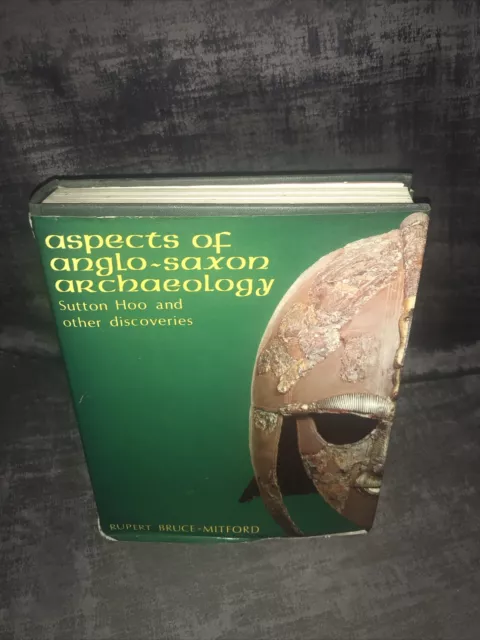
Aspects Of Anglo Saxon Archaeology Sutton Hoo By Rupert Bruce Mitford HB DJ 1974
$75.91 0 Bids 2d 0h
The Sutton Hoo Ship Burial
$58.25 Buy It Now 22d 20h
The Treasure Von Sutton Hoo: Ship-Burial für An Anglo-Saxon King
$16.29 Buy It Now 20d 16h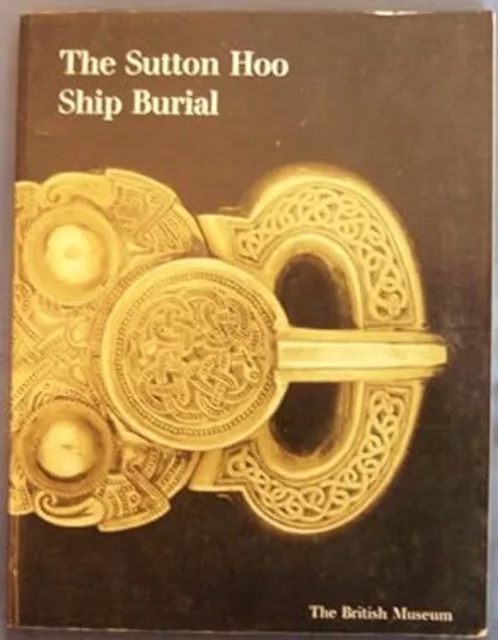
The Sutton Hoo Ship-Burial: Ein Handbuch Rupert Leo Scott Bruce-Mi
$30.75 Buy It Now 30d 0h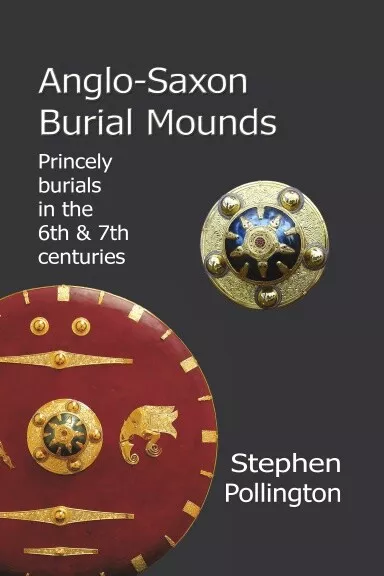
Anglo-Saxon Burial Mounds
$97.93 Buy It Now 24d 11h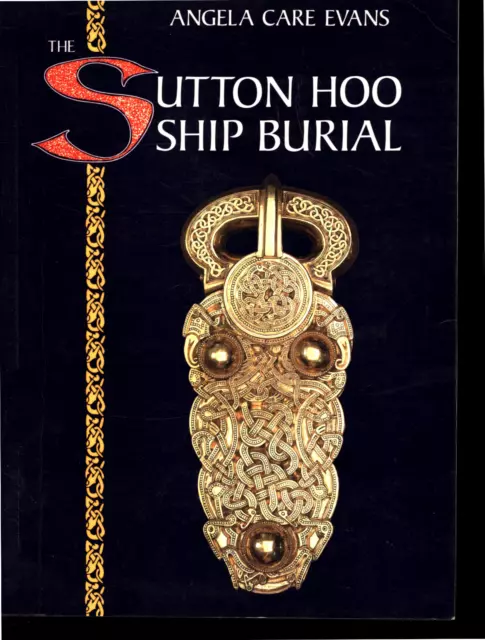
Angela Care Evans The Sutton Hoo Ship Burial
$9.90 Buy It Now 18d 23h
Sutton Hoo Ship Burial: A Handbook by Bruce-Mitford, Rupert Hardback Book The
$32.22 Buy It Now 18d 16h
The Sutton Hoo ship burial: A handbook
$23.11 Buy It Now 7d 19h
5 British Museum Objects in Focus: The Sutton Hoo Helmet * The Lewis Chessmen *
$20.44 Buy It Now 25d 12h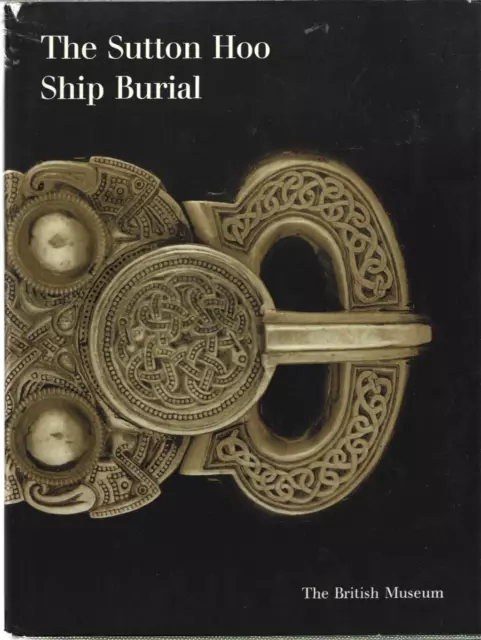
The Sutton Hoo Ship Burial: A Handbook, by Rupert Bruce-Mitford (British Museum)
$33.29 Buy It Now 30d 1h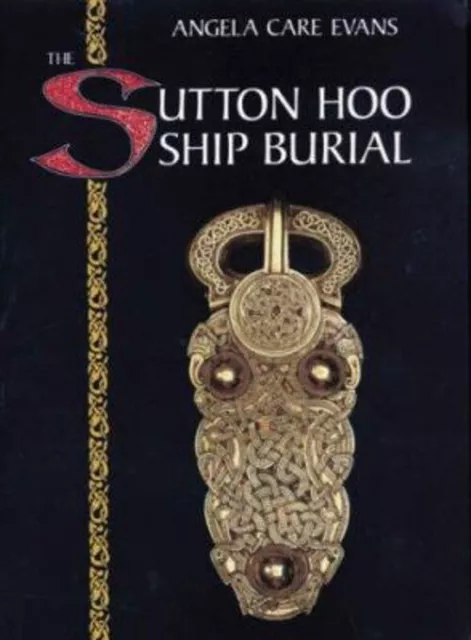
Sutton Hoo Ship Burial Hardcover Angela Care Evans
$16.07 Buy It Now 26d 8h
The Sutton Hoo Ship Burial: R.L.S. Bruce-Mitford; new edition
$9.24 Buy It Now 10d 19h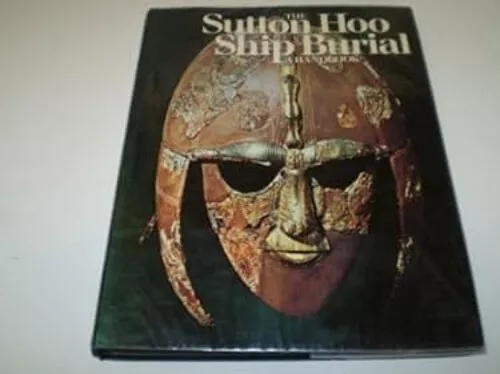
The Sutton Hoo Ship Burial : A Handbook Rupert Leo Scott Bruce-Mi
$40.89 Buy It Now 3d 20h
Sutton Hoo Ship Burial Hardcover Angela Care Evans
$16.07 Buy It Now 19d 21h
The Sutton Hoo Ship Burial. Evans, Angela Care:
$24.73 Buy It Now 28d 23h
Sutton Hoo: The Excavation of a Royal Ship-Burial, Charles Green,
$51.67 Buy It Now 24d 10h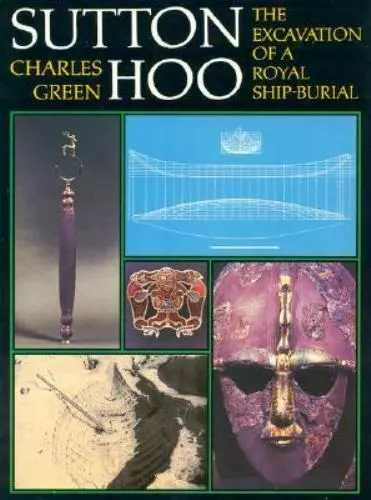
Sutton Hoo: The Excavation of a Royal Ship-Burial, Green, Charles, 9780389207757
$39.92 Buy It Now 2d 1h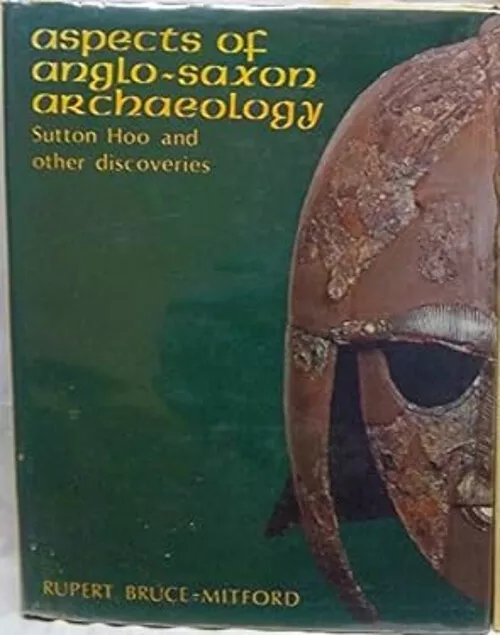
Aspects of Anglo-Saxon Archaeology : Sutton Hoo and Other Discove
$25.74 Buy It Now 19d 8h
Aspekten Von Anglo-Saxon Archäologie: Sutton Hoo Und Other Discovery
$126.20 Buy It Now 10d 9h
Treasure of Sutton Hoo : Ship-Burial for an Anglo-Saxon King, Paperback by Gr...
$26.49 Buy It Now 1d 10h
Sutton Hoo: The Excavation of a Royal Ship-Burial by Green, Charles
$16.84 Buy It Now 30d 21h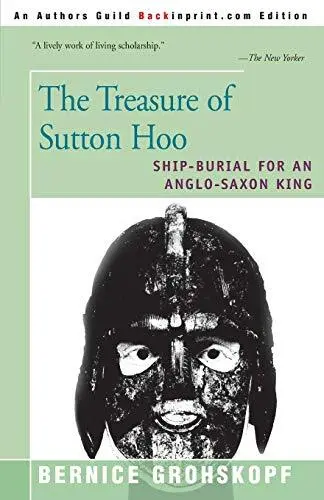
The Treasure of Sutton Hoo: Ship-B... by Grohskopf, Bernice Paperback / softback
$19.24 Buy It Now 21d 22h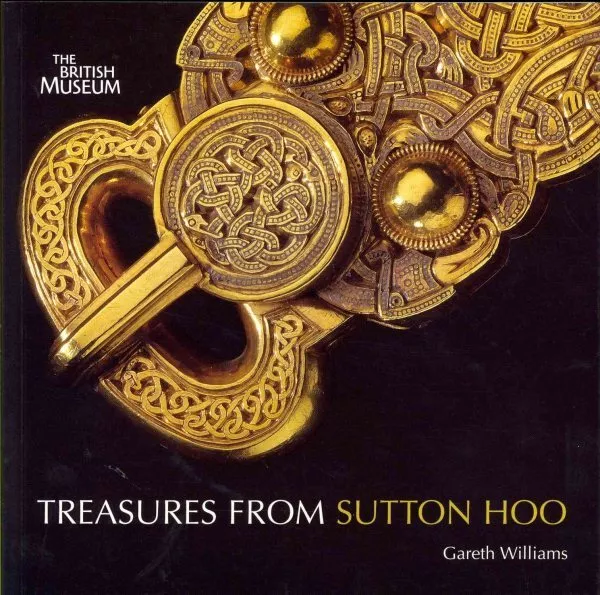
Treasures From Sutton Hoo, Paperback by Williams, Gareth, Brand New, Free shi...
$18.14 Buy It Now 27d 18h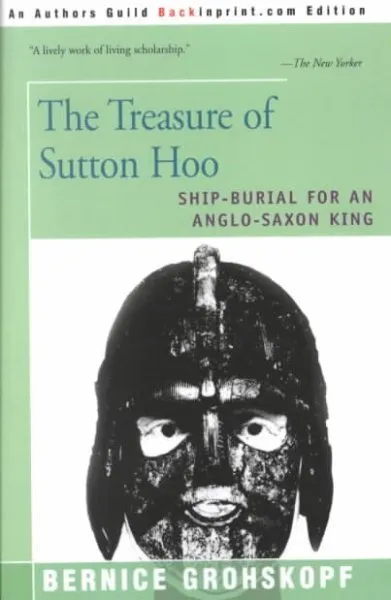
Treasure of Sutton Hoo : Ship-Burial for an Anglo-Saxon King, Paperback by Gr...
$26.51 Buy It Now 1d 10h
The Sutton Hoo Schiff Burial: Ein Handbuch Rupert Leo Scott
$15.75 Buy It Now 6d 7h![Sutton Hoo: The Excavation of a Royal Ship-Burial [ Green, Charles ] Used - Good Sutton Hoo: The Excavation of a Royal Ship-Burial [ Green, Charles ] Used - Good](https://www.picclickimg.com/QCQAAOSwToJf~rjt/Sutton-Hoo-The-Excavation-of-a-Royal-Ship-Burial.webp)
Sutton Hoo: The Excavation of a Royal Ship-Burial [ Green, Charles ] Used - Good
$17.30 Buy It Now 26d 21h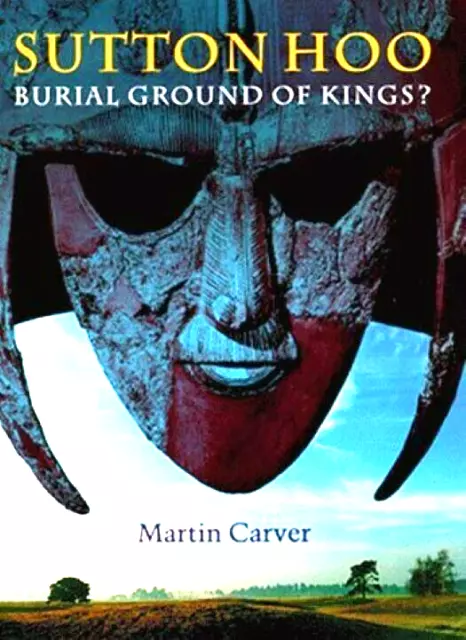
SUTTON HOO : Burial Ground of Kings? By Martin Carver
$3.32 Buy It Now 4d 18h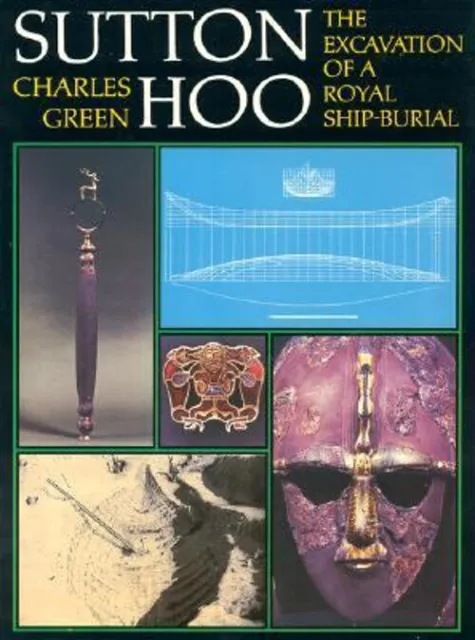
Sutton Hoo : The Excavation of a Royal Ship-Burial Hardcover Char
$16.29 Buy It Now 2d 11h
Treasures from Sutton Hoo by Gareth Williams (English) Paperback Book
$21.65 Buy It Now 26d 7h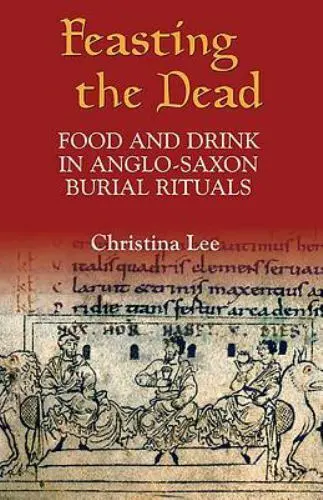
Feasting the Dead: Food and Drink in Anglo-Saxon Burial Rituals: By Christina...
$229.45 Buy It Now 18d 21h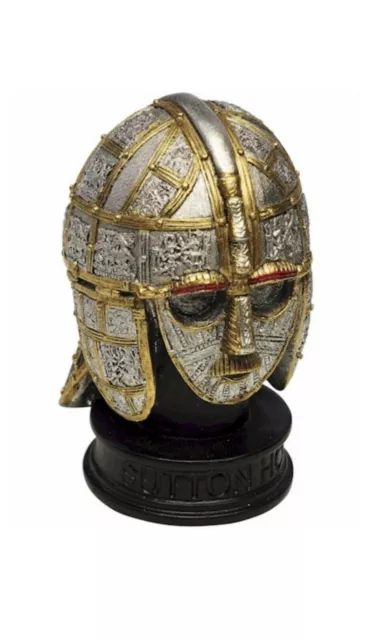 55 watchers
55 watchersSutton Hoo Helmet Medieval Anglo Saxon Artefacts Find Burial Ship Ornament
$27.60 Buy It Now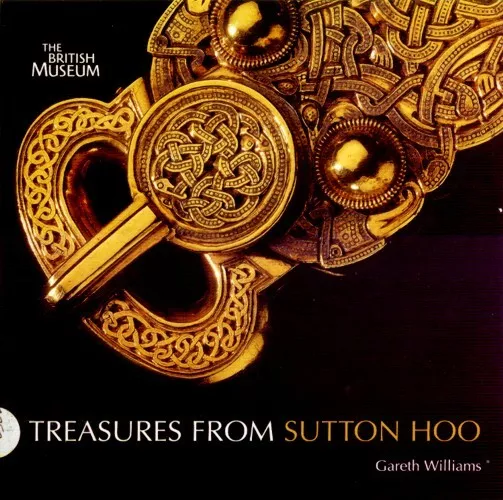 15 watchers
15 watchersSutton Hoo Treasures Anglo-Saxon Ship Burial Gold + Garnet Jewelry Sword Helmet
$64.89 Buy It Now
Sutton Hoo Treasures Anglo-Saxon Ship Burial German English Jewelry Sword Helmet
$64.89 Buy It Now

